Winter in Japan is a season filled with delicious foods. This time, to delight visitors, we will explore traditional Japanese home-cooked dishes unique to winter, focusing on the theme of “O-fukuro no Aji” or “Mom’s Taste.”
Taste the Regional Flavors of Hot Pot Dishes
Hot pot dishes are a quintessential part of winter in Japan, with various types available across different regions, each offering distinct flavors.
Sukiyaki

Sukiyaki is a traditional hot pot dish that perfectly suits Japan’s winter. Particularly cherished in the Kansai region, this dish features thin slices of beef and fresh vegetables simmered in a sweet and savory soy sauce-based broth, creating a rich and delightful taste.
The main ingredients for sukiyaki include thinly sliced beef, chosen for its tenderness and balanced fat content to enhance flavor. Seasonal vegetables like leeks, napa cabbage, chrysanthemum greens, shirataki noodles, and shiitake mushrooms are also used abundantly. Adding grilled tofu enriches the texture and flavor. Generally, the finished sukiyaki is dipped in raw egg, adding a creamy touch that enhances the overall taste.
A crucial component of sukiyaki’s flavor is the “warishita,” a sweet and savory broth made by combining traditional Japanese seasonings like soy sauce, mirin, sugar, and sake. These ingredients are brought to a boil over medium heat, allowing the flavors to blend harmoniously.
Shabu-Shabu
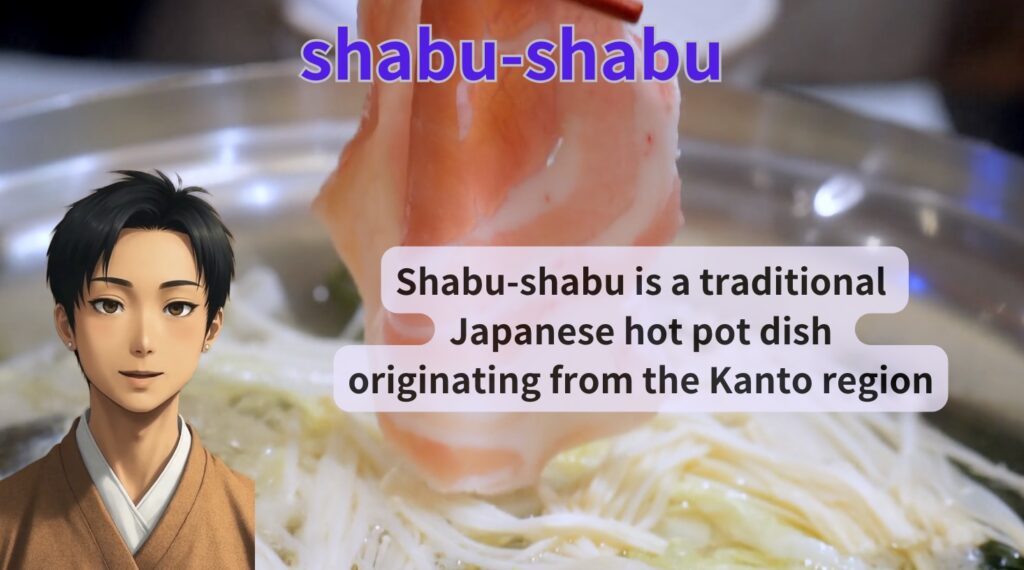
Shabu-shabu is a traditional Japanese hot pot dish originating from the Kanto region. Its appeal lies in lightly swishing thin slices of meat and fresh vegetables in boiling water and enjoying them with your choice of dipping sauces. Pork is commonly used, especially low-fat cuts, making shabu-shabu a healthy, light dish beloved by many.
To prepare shabu-shabu, start by filling a pot with water and adding kombu to make a broth. Once the water boils, remove the kombu and cut vegetables like napa cabbage, chrysanthemum greens, enoki mushrooms, shiitake mushrooms, tofu, and pea shoots into bite-sized pieces. Begin by cooking the vegetables in the boiling broth. Then, dip the thinly sliced meat into the hot water for a few seconds until the color changes, and indulge in the prepared dipping sauces.
The joy of shabu-shabu is in savoring the natural flavors of the ingredients. Ponzu offers a refreshing citrus tang, while sesame sauce provides a rich and creamy taste. These sauces enhance the umami of the meat and vegetables, making the meal even more enjoyable. Additionally, selecting seasonal vegetables and seafood for shabu-shabu allows for creative variations. Simple yet profound, shabu-shabu is a dish that embodies the richness of Japanese food culture.
Motsunabe
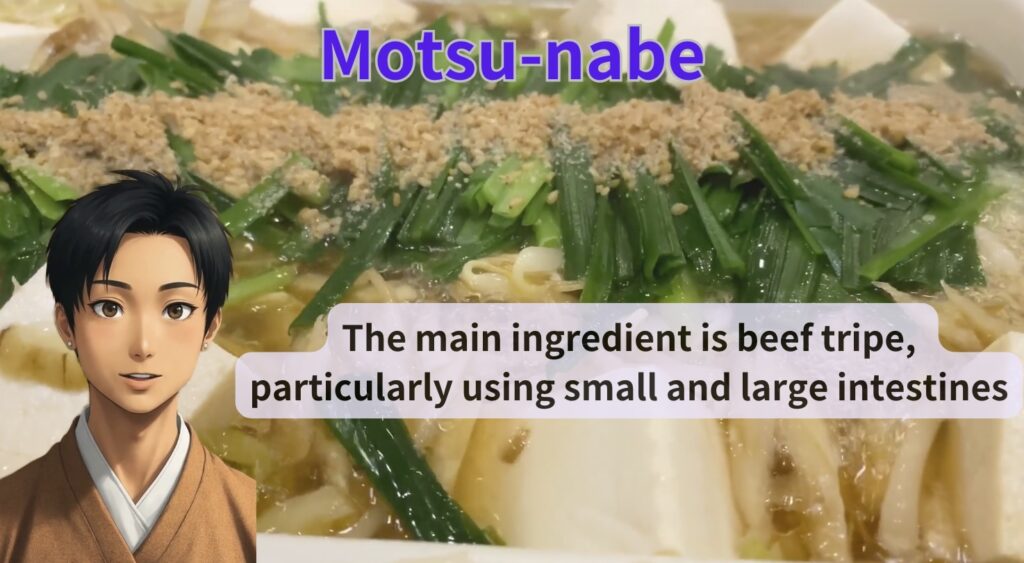
Motsunabe is a hot pot dish representing Fukuoka, perfect for warming up during Japan’s cold winter months. The main ingredient is beef tripe, particularly using small and large intestines. The tripe is tender and juicy, and simmering it in a miso-based broth brings out its unique flavor. The rich umami of the tripe infuses the soup, warming you up from the inside out.
The broth for motsunabe is primarily miso-based, though some regions use a soy sauce base. Essential ingredients include garlic chives, sweet cabbage, gentle-flavored tofu, and garlic, which enhances the dish’s aroma. Start by filling a pot with water and preparing a broth using kombu and bonito flakes. Lightly boil the beef tripe in hot water to remove excess fat and odor, then dissolve miso in the broth and add garlic to create the soup. Adding chili peppers or sesame oil to taste can further enrich the flavor. After placing the vegetables into the soup, simmer them over low heat. Finally, add the prepared tripe and lightly simmer to complete the dish.
Once the tripe softens and the soup’s flavor permeates, motsunabe becomes a comforting dish. Not only can you enjoy the ingredients with the soup, but adding noodles or rice at the end provides a different, delicious experience. Adding noodles as a “shime,” or closing dish, is common, allowing you to savor every bit of the tripe’s umami absorbed into the soup.
Enjoy the Gentle Flavors of Simmered Dishes
Simmered dishes are a staple of Japanese home cooking. By slowly simmering the ingredients, their flavors are condensed, offering a deep and satisfying taste.
Oden

Oden is a traditional simmered dish essential to Japanese winters, widely enjoyed at home and street stalls to ward off the cold. The charm of this dish lies in its simplicity, featuring various ingredients slowly simmered in a flavorful broth, with regional and household variations in ingredients and seasoning adding unique character.
To prepare oden, begin by making the broth. Fill a pot with water, add kombu, and let it soak for a while before adding bonito flakes and bringing it to a boil. Strain the broth to create a clear base. Next, choose your ingredients, such as daikon radish, konjac, boiled eggs, fish cakes, chikuwa, and tofu pouches. Some regions may include beef tendon, mochi pouches, or octopus.
Prepare the ingredients by cutting the daikon into thick slices and pre-boiling them, boiling the konjac to remove any odor, and making boiled eggs. When ready to simmer, add soy sauce, mirin, and sugar to the broth for seasoning. Gradually add the ingredients, starting with those that take longer to cook, like daikon and konjac, and simmer slowly over low heat to allow the broth’s umami to infuse them.
Oden’s seasoning often focuses on the broth’s umami, with soy sauce adding color and mirin and sugar providing a slight sweetness. Some regions use miso or serve it with yuzu pepper for a unique twist, reflecting the individuality of each household and region.
The allure of oden is in the variety of flavors offered by its ingredients. The broth-soaked daikon becomes tender and melts in your mouth, while konjac and chikuwa offer enjoyable textures. Fish cakes and tofu pouches, with their fried aroma, add depth to the overall taste. Adding mustard for a spicy kick enhances the flavors even further.
Nikujaga
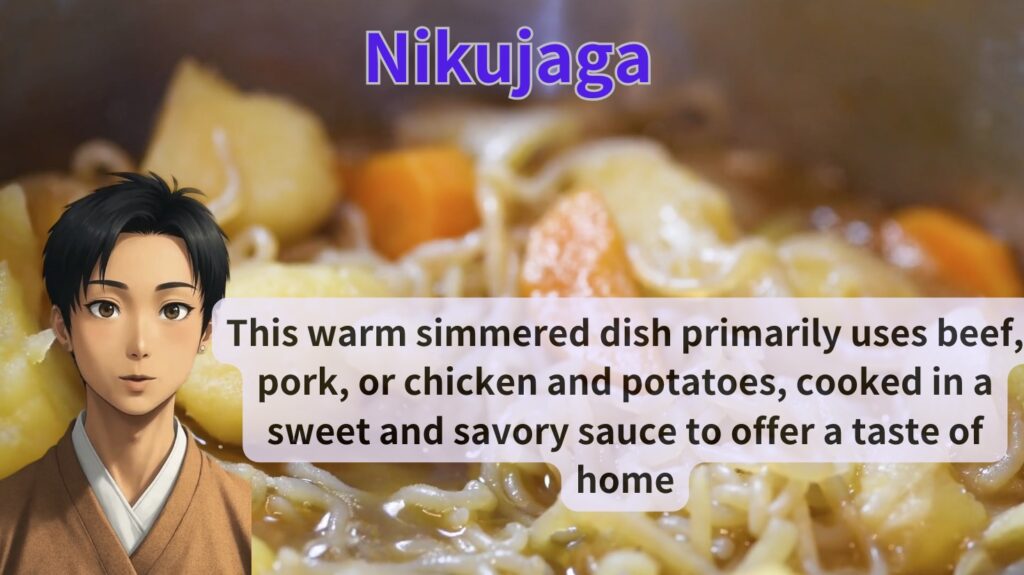
Nikujaga is a beloved Japanese home-cooked dish, especially fitting for the cold season. This warm simmered dish primarily uses beef, pork, or chicken and potatoes, cooked in a sweet and savory sauce to offer a taste of home. Despite its simplicity, nikujaga’s cooking method highlights the natural flavors of its ingredients, making it a favorite in many households.
The main ingredients for this dish include meat, potatoes, onions, and carrots. While preferences for the type of meat vary by household, thinly sliced beef is commonly used. Potatoes are a crucial element, softening and absorbing the sweet and savory broth as they cook. Onions add sweetness, and carrots provide a pop of color. These vegetables also enhance the overall flavor when simmered.
The preparation is relatively simple. First, peel and cut the potatoes into bite-sized pieces, slice the onions into wedges, and cut the carrots into chunks. Cut the meat into bite-sized pieces as well. Heat a small amount of oil in a pot, and sauté the meat until it changes color. Add the onions and carrots, and continue sautéing. Then, add the potatoes, water, soy sauce, mirin, sugar, and sake for seasoning. Bring the pot to medium heat, skim off any scum, cover, and simmer over low heat for about 20 to 30 minutes until the potatoes are tender. Remove the lid and reduce the broth to adjust the flavor.
Nikujaga’s seasoning is characterized by its sweet and savory soy sauce base. The subtle sweetness from mirin and sugar enhances the umami of the meat and vegetables. Adding sake boosts the aroma, bringing the flavors together.
Despite its simple ingredients, nikujaga is a dish with a profound taste. The subtle differences in seasoning from household to household mean there are as many variations of nikujaga as there are families. This dish is a representative of Japan’s “O-fukuro no Aji,” loved by many for its heartwarming nature.
Buta no Kakuni
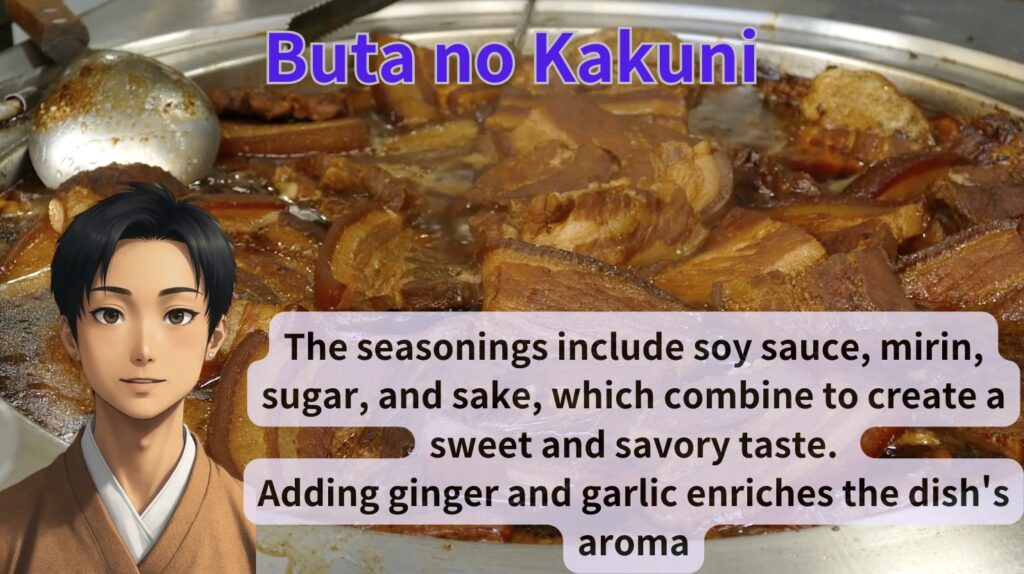
Buta no Kakuni is a traditional Japanese home-cooked dish made by slowly simmering pork belly. Known for its tender meat and sweet and savory seasoning, this dish is cherished in many households. It is especially popular during the cold winter months and pairs perfectly with rice.
The main ingredient is fatty pork belly, which becomes tender and melt-in-your-mouth through simmering. The seasonings include soy sauce, mirin, sugar, and sake, which combine to create a sweet and savory taste. Adding ginger and garlic enriches the dish’s aroma.
To prepare buta no kakuni, cut the pork belly into bite-sized pieces and place them in a pot with water over heat. Once it boils, skim off any scum and simmer for a few minutes to remove excess fat. Remove the meat and drain it. In another pot, add the pork, ginger, garlic, soy sauce, mirin, sugar, and sake. Add enough water to cover the ingredients and simmer over low heat for 2-3 hours, allowing the meat to become tender and the flavor to infuse. Once the broth reduces and the meat is tender, stop the heat and remove any excess fat before serving, glazing the meat with the remaining shiny broth.
Buta no Kakuni’s sweet and savory seasoning pairs beautifully with rice. The simmering process melts the pork’s fat, resulting in a tender and juicy texture. Adding a soft-boiled egg or greens enhances the presentation and flavor. Buta no Kakuni, embodying Japan’s “O-fukuro no Aji,” is a dish that foreigners must try, offering a deep, home-cooked flavor achieved through slow simmering.
Experience Japanese Home Cooking at Chain Restaurants
For a convenient taste of Japanese home-cooked meals, Japanese cuisine chain restaurants are recommended.
Shabu-Yo

Shabu-Yo is a popular shabu-shabu chain with locations throughout Japan, recommended for foreign visitors looking to enjoy this traditional dish. Known for offering high-quality shabu-shabu at reasonable prices, Shabu-Yo features a diverse menu with beef, pork, and chicken options, allowing guests to choose different cuts and enjoy seasonal special meat menus. This variety ensures a new taste experience with each visit.
One of Shabu-Yo’s attractions is its abundant vegetable bar, where guests can freely choose fresh seasonal vegetables for their shabu-shabu. With options like cabbage, napa cabbage, spinach, bean sprouts, and mushrooms, healthy ingredients abound. Noodles and tofu are also available for guests to mix and match according to their preferences.
Additionally, Shabu-Yo provides a wide array of sauces and condiments to enhance the shabu-shabu experience. Beyond ponzu and sesame sauce, guests can create their ideal flavor combination, enjoying different tastes with each visit.
Shabu-Yo’s all-you-can-eat plan is popular, allowing guests to enjoy unlimited meat and vegetables within the allotted time. Ideal for big eaters and families, the time-limited offer ensures a satisfying meal.
Shabu-Yo is recommended for foreign visitors as a place to experience traditional Japanese shabu-shabu easily. Many locations offer English menus, enabling guests to order without language barriers. The interactive style of choosing ingredients and cooking them is enjoyable even for first-timers, and the restaurant’s popularity among foreign tourists makes it a great spot for cultural exchange.
Ootoya

Ootoya is a popular set meal chain with locations across Japan, offering a taste of traditional Japanese home-cooked meals at reasonable prices. Particularly recommended for foreign visitors, Ootoya provides a casual way to experience Japan’s “O-fukuro no Aji.”
Ootoya offers a wide range of set meal menus, featuring a main dish (fish or meat) served with rice, miso soup, and small side dishes, representing Japan’s traditional meal style. This format allows for a balanced meal in one sitting. Seasonal limited menus are also available, showcasing dishes made with fresh ingredients, offering a new experience with each visit.
Highlighting the menu are dishes like Chicken with Black Vinegar Sauce, Grilled Mackerel Set Meal, and Pork Soup Set Meal. The Chicken with Black Vinegar Sauce is a popular choice, featuring chicken cooked in a sweet and sour black vinegar sauce, offering a hearty meal. The Grilled Mackerel Set Meal presents freshly grilled mackerel in a simple salt preparation, highlighting the fish’s umami. The Pork Soup Set Meal, with its hearty ingredients, warms both heart and body.
Ootoya’s dishes are known for their healthy, home-cooked flavors, prepared in-house for a handmade feel. The menu considers nutritional balance, with many vegetable-rich dishes available, providing healthy options for health-conscious diners.
Most locations offer English menus, ensuring foreign visitors can order confidently. The staff is friendly, making Ootoya a welcoming place to dine, even for first-timers.
Dining at Ootoya offers an excellent opportunity to experience the richness of Japanese home cooking. Enjoy the heartwarming taste of Japan.
Yayoi Ken
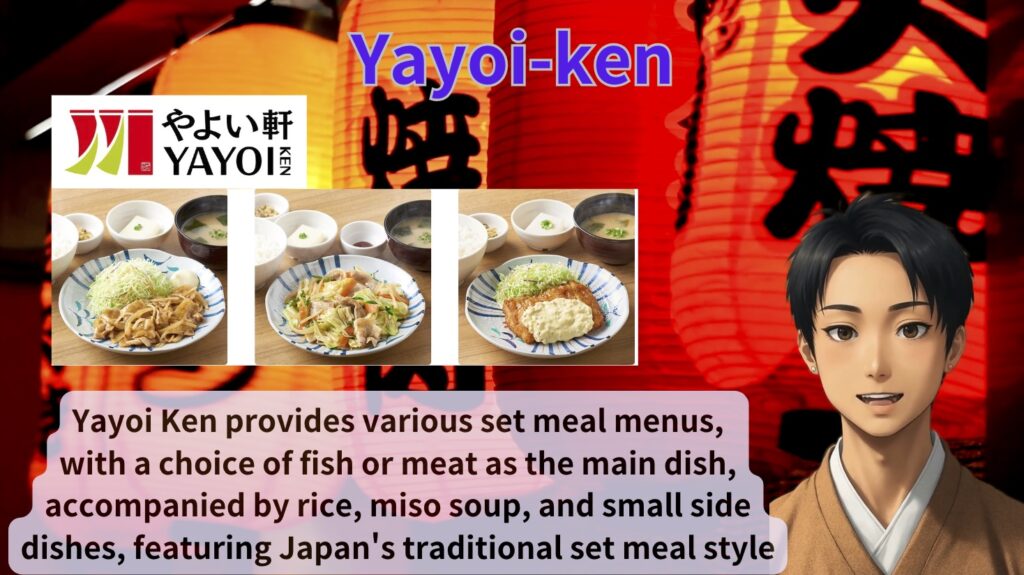
Yayoi Ken is a popular set meal chain with locations throughout Japan, loved by many Japanese and recommended for foreign visitors. Its appeal lies in offering balanced meals at reasonable prices.
Yayoi Ken provides various set meal menus, with a choice of fish or meat as the main dish, accompanied by rice, miso soup, and small side dishes, featuring Japan’s traditional set meal style. This format allows for a balanced and convenient dining experience. Popular menu items include Ginger Pork Set Meal, Grilled Mackerel Set Meal, and Chicken Nanban Set Meal, featuring fried chicken with sweet vinegar and special tartar sauce.
The restaurant’s appeal includes its clean and comfortable atmosphere, with many locations offering table seating suitable for families and groups. The self-service rice refill system ensures guests can eat to their heart’s content.
Yayoi Ken caters to foreign visitors by offering English and other foreign language menus at many locations. The menu comes with photos, allowing guests to order without language barriers, and the staff’s courteous service ensures a pleasant dining experience, even for newcomers.
Yayoi Ken is an excellent place to experience Japanese home cooking conveniently, making it a perfect choice for those seeking to enjoy Japan’s “O-fukuro no Aji.” Be sure to visit.
Conclusion
Japan’s winter offers a bounty of delicious foods. Alongside the home-cooked dishes introduced here, countless other delightful dishes await. Explore various restaurants to find your favorite “O-fukuro no Aji.”


